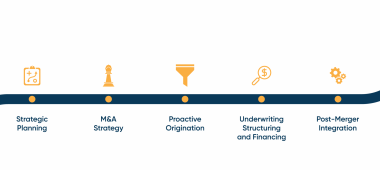This article was originally posted on South Florida Business Journal.
If you’ve ever spoken with an investment banker or broker about selling or raising capital for your business, you’ve undoubtedly heard about EBITDA. EBITDA — or earnings before interest, taxes, depreciation and amortization — is a widely used earnings metric, particularly when quoting valuation “multiples” (i.e., a company’s valuation divided by its adjusted EBITDA).
EBITDA gives investors an understanding of how your company is performing financially. It is a rough proxy for a company’s ability to generate cash, without the effects of debt. While imperfect, EBITDA is a standardized approach that minimizes the effects of accounting decisions, making it easier to compare your company’s performance to its peers and to discuss valuation on an apples-to-apples basis (this can be challenging given the inherent subjectivity in some of the adjustments).
Adjusted EBITDA starts with the net income reported on your income taxes, adds back the accounting categories mentioned above, and is then “normalized” to reflect the true earning capacity of the business going forward if it was independent of its current ownership.
While there can be many gray areas, the key question to ask is whether a certain expense will continue to be necessary after the business is sold. While it might be tempting to try to aggressively add back anything you can possibly rationalize, I find this to be counterproductive because your credibility and integrity are on the line. Buyers will scrutinize every adjustment and eventually will expect underlying documentation to validate each one.
EBITDA add-backs broadly fall into two categories: nonrecurring and personal expenses.
Nonrecurring expenses
Nonrecurring expenses are expenses resulting from one-time events that are not expected to happen again and are outside the ordinary course of business. Some typical examples include:
• Expenses related to damage from a natural disaster.
• Litigation costs from unusual sources.
• Professional fees associated with preparing the business for sale (brokers, attorneys, etc.).
• Capital expenses that were characterized as repairs and maintenance to minimize taxable income.
• Inventory that was expensed to minimize taxable income.
The most important consideration, as the name suggests, is that these expenses are indeed nonrecurring. This leaves room for interpretation. For example, if your business is engaged in lawsuits year after year, and such lawsuits are expected to continue, it clearly would be inappropriate to add those costs back, as they are part of the ordinary course of business. On the other hand, in today’s litigious society, nearly all companies will experience some litigation (whether there’s any merit or not). For most businesses, the solution is to add back a portion of these expenses, which functionally accrues some reserve annually for lawsuits (like a bad debt reserve).
Personal expenses
Personal expenses are often run through a business to reduce tax liability. These expenses should be added back because they will end once the business is sold. These include:
• Payments to family members who are not actively involved in operations.
• Above-market salaries paid to the owners.
• Bonuses serving as shareholder distributions.
• Any other expense that is personal in nature.
This category also includes discretionary expenses, such as charitable contributions and food and entertainment expenses.
Negative add-backs
Despite the name, EBITDA add-backs won’t always increase the earnings of your business. Remember, the purpose of EBITDA add-backs is to reflect the true economic earning potential of the business if a third party owned it. Sometimes, negative add-backs are necessary for items that are expected to decrease the earnings of the business going forward.
If the business owner personally owns the land where the business is located and charges below-market rent, the rent expense should be increased to reflect the cost to new owners who will not get the same favorable rate. If the business owner receives a below-market salary, this expense should be adjusted to reflect the cost of hiring someone of equal skill and ability. Maybe the business owner does not intend to sell all the business’s assets as part of the transaction. In that case, any revenues associated with those assets should be removed to reflect the actual earning ability without those assets.
Proactively volunteering these negative add-backs helps to build trust with potential buyers. It shows that you are not trying to pull one over on the buyer by overstating the value of the business.
EBITDA add-backs create a clear picture of your business’s cash flow that makes it easier to understand how much your business is worth. Work with an experienced professional who thoroughly understands this process to ensure you get the most value for your business.














